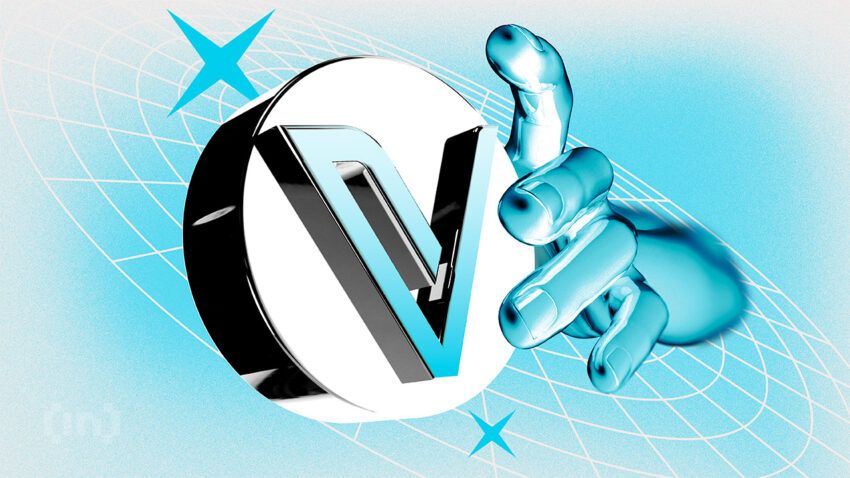VeChain (VET) is an advanced layer-1 public blockchain and smart contract platform tailored for practical use in real-world commercial environments. This guide covers what to know about the VeChain project and native VET crypto in 2025.
KEY TAKEAWAYS
• VeChain is a smart contract platform that integrates with the internet of things (IoT) to enhance business processes.
• It utilizes a proof of authority mechanism which allows it to optimize for speed, security, and energy efficiency.
• VeChain operates with two native tokens, VET for transactions and VTHO for blockchain operations.
• The governance model balances decentralization and centralization to achieve both efficiency and transparency.
What is VeChain?
VeChain is a blockchain-based platform focused on providing transparency, traceability, and improved blockchain functionalities to real-world businesses. In simple terms, VeChain combines blockchain technology with the Internet of Things (IoT) to improve data management, increase transparency, and drastically enhance the efficiency of business processes.
Initially conceived as a solution for supply chains running on the Ethereum blockchain, VeChain evolved in 2018 and launched its own smart contract platform — VeChainThor — to tackle a diverse array of real-world applications.
To widen real-world adoption, this open-source network allows users to build DApps that solve real-world problems. Industries such as logistics, food chain service, tourism, health, and food safety have tapped its unlimited potential.
Origin of VeChain

Founded in 2015, VeChain is the brainchild of Jay Zhang and Sunny Lu. Lu formerly served as the Chief Information Officer of Louis Vuitton in China.
When I spent 2-3 years in the Bitcoin community at that time, I just feel lots of people have been talking technical only about the codings, the protocols, and consensus, block time, all of that stuff. And I felt, if the technology needs to really go to the real world, building up really cool products, useful products for people…to be able to use everyday, let’s say it requires more than technology.
Sunny Lu, VeChain CEO
It is headquartered in San Marino, Europe, and Singapore and holds offices in China, Singapore, Luxembourg, Japan, Ireland, France, Italy, and the United States.
VeChain was first conceptualized for IoT and supply chain management. At the time, it was using VEN tokens before it transitioned into its own blockchain in mid-2018 to improve scalability. It is now represented by VET — a native token that lets people transact on the blockchain.
Core features of VeChain
VeChain offers numerous functions to several companies around the world. It is one of the first blockchain companies to balance reliability and efficiency. Providing transparency, VeChainThor has integrated many tools, including KYC, to ensure smart contracts support it. Let’s have a look at some of its key features.
Inherent governance tools
VeChain combines decentralization and centralization to attain a balance in offering optimal service. Decentralization, being the centerpiece of blockchain technology, has proven to suffer scalability issues in some blockchain networks, such as Bitcoin and Ethereum.
VeChain balances this by building VeChainThor, which aims to build a governance model with continuous integrations and developments. The governance framework and principles are designed for clarity, inclusiveness, transparency, scalability, and efficiency. This speeds up the overall performance, and progress of the ecosystem.
VeChain ToolChain
To further make VeChain suitable for mass adoption, the platform invested quite a lot into launching VeChain ToolChain — a well-coded comprehensive blockchain software backed by the VeChainThor blockchain.
It offers software as a service (SaaS) to small and mid-size enterprises to further enhance their business model. VeChain ToolChain provides unique ways for businesses to re-invent their supply chain and run their businesses more efficiently. Other features include:
- Transparency
- Product traceability
- Data storage
- Creative ways to boost consumers’ experience
How does VeChain (VET) work?
With security as its center value, VeChain uses deterministic pseudo-random processes (DPRP) to select nodes. As a result, it designed the concept of the “active/inactive” status of authority masternodes to maximize efficiency.
This design helps users know whether a particular validator is authorized to produce a block or not. It is mostly for big businesses and organizations that prioritize security over other possible features.
Additionally, VeChain uses a modified version of proof of stake called Proof-of-Authority (PoA). Instead of staking your coins, Vechain Foundation decides who can become a validator (authority masternode). Therefore, VeChainThor is more centralized.
Proof-of-Authority (PoA)
- Low energy fee
- Improved block validation speed
- Not entirely dependent on authority masternodes
- Improved side-chain capability
- Increases scalability by running on just a few nodes
- Enabled for IoT solutions
VeChain combines IoT on the blockchain, creating many possibilities. This includes digital identification and ownership of devices, as well as authentication, privacy, and security.
VeChain Tokens — VET and VTHO

The VeChain ecosystem has two native tokens, VeChain Token (VET) and VeChainThor Energy, a.k.a. VeThor (VTHO). VET is the primary token that runs all the operations on the platform, while VTHO ensures optimal functionality of the whole blockchain infrastructure.
In other words, VTHO represents the energy used in running payment transactions on smart contracts deployment to occur on the network. Its main goal is to facilitate transactions on the blockchain.
Big companies harnessing VeChain
In 2019, Walmart, one of the biggest multinational retail corporations that operates a chain of hypermarkets, announced a partnership with VeChain. VeChain and Walmart’s partnership enables users to track food delivery in China via an app, displaying product information and traceability information such as storage conditions, delivery time, pick-up time, and more.
The Chinese government, under the strict Gui’an regulations, also announced a partnership with VeChain in 2017. Other partnerships include PwC, DNV Grant Thornton, LVMH, etc.
Overall, VeChain is helping hundreds of companies track products from the manufacturer to the consumer, ensuring quality and assisting companies in spotting any disparities or counterfeits.
Does VeChain have competitors?
VeChain is the king of platforms in the blockchain IoT space. It boasts more than 200 successful partnerships worldwide, and its total market cap is more than $1 billion. Back in 2018, a few worthy competitors such as Ambrosus(AMB) and Waltonchain(WTC) arose.
Ambrosus (AMB) is a utility token based on the Ethereum protocol. It is limited in scalability. The platform has a few partnerships with Blendhub and Flatev, which are fewer than VeChain.
Another competitor is Waltonchain. Running on Ethereum, the project combines blockchain with IoT (RFID) to create a smooth supply chain system. Compared to VeChain, it has fewer partnerships.
However, numerous crypto enthusiasts have reported these above competitors as scam projects. It’s important to do enough research on them if you’re considering investing in them. Other possible competitors are OriginTrail (TRAC), IOTA, and Antchain.
Tokenomics

VeChain first launched its token, VEN, through an ICO from August 2017 to September 2017. The project raised $20 million. Initially, 1 billion VEN tokes were created. After 133 million tokens had been burned as part of a distribution plan, there would only be about 867,162,634 VEN in circulation. The distribution of VEN tokens was as follows:
- Public ICO: 410 million VEN
- Private sale: 90 million VEN
- Enterprise investors: 128.5 million VEN
- VeChain team: 270 million VEN
In August 2018, the VeChain mainnet went live, and all VEN tokens were swapped to VET with a ratio of 1:100.

Overall, VeChain is in the top 50 global cryptocurrencies by market cap as of Aug. 19, 2024. There are over 86 billion VET coins in circulation. Furthermore, it has more than 1.6 million known addresses, about 16,000 contracts known, and over 2,000 X-Node tokens.
Roadmap and developments
VeChain seems to have invested a lot in building its infrastructure. Below is a diagram showing the whole VeChain journey.
Now, the platform has been used in several other industries. It is often regarded as the pioneer of real-world blockchain applications. Here is a brief timeline of its many milestones:
- June 2015: First VeChain launch
- November 2016: Introduced smart contract models for DBMSP, DBGP, and DGIP.
- May – July 2017: Started many business integrations from the automotive, agricultural, and auditing industries. At this time, the VeChain Foundation was also founded.
- June 2018: Launch of VeChainThor after racking up more than $1 billion.
- August 2020: COVID-19 safety protection certificates via ToolChain.
- November 2021: VeChain upgrades to Proof-of-Authority 2.0 consensus.
- February 2024: VeBetterDAO, a DApp and DAO that allows individuals, NGOs, and businesses to tokenize and reward their sustainable activities.
Should you buy VeChain (VET)?
VET does have potential and could possibly be a good investment. Despite the crypto market’s volatility, it has shown growth over the past few years and has massive prospects for further growth.
However, before you consider buying any project, you should do your own research (DYOR) and analyze the possible market price for VET. Do some technical analysis — support level and resistance level to minimize the risk and trade safely.
If you want to know more about VeChain’s possible price trajectory, check out our VeChain price prediction crafted by BeInCrypto experts.
What is next for VeChain?
VeChain is an enterprise blockchain with long-term goals to enhance efficiency and sustainable practices for businesses utilizing web3 technologies. It has successfully created enterprise-blockchain solutions, which led to its worldwide adoption. With builders continuing to innovate and utilize tokenization in 2025, the future looks bright for VeChain.
However, while it is a use-case-packed project with a host of real-world applications, potential investors in VET should proceed with caution. Always employ a comprehensive DYOR strategy and never invest more than you can afford to lose.
Disclaimer: This article is intended for informational purposes only and should not be considered investment advice. Crypto is a volatile asset and profits are never guaranteed.
Frequently asked questions
Why is VeChain special?
Is VeChain legit?
Who owns VeChain Crypto?
What is the VeChain coin used for?
Disclaimer
In line with the Trust Project guidelines, the educational content on this website is offered in good faith and for general information purposes only. BeInCrypto prioritizes providing high-quality information, taking the time to research and create informative content for readers. While partners may reward the company with commissions for placements in articles, these commissions do not influence the unbiased, honest, and helpful content creation process. Any action taken by the reader based on this information is strictly at their own risk. Please note that our Terms and Conditions, Privacy Policy, and Disclaimers have been updated.




